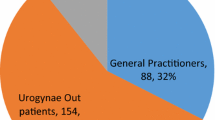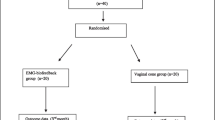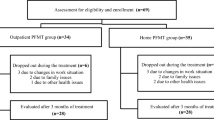Summary
Purpose: The aim of the study was to determine the short- and long-term efficacy of an intensive and EMG-biofeedback-assisted pelvic floor muscle training (PFMT) program as a therapy of female stress or mixed urinary incontinence. Materials and methods: All women with stress or mixed urinary incontinence treated in the pelvic floor reeducation program at our clinic between September 1996 and March 2003 were included. EMG-biofeedback assisted PFMT was performed by specially trained therapists (one registered nurse and one midwife). Electric stimulation preceded PFMT if the pelvic floor muscle contractions were considered too weak for active training (Oxford < 2). Examinations included among others: conventional urodynamic studies prior to therapy, a stress provocation test (cough test), and determination of maximal pelvic floor muscle strength (Oxford-grading and electric EMG-potential). A retrospective chart review was performed. A questionnaire was administered for long-term follow-up. Results: Four hundred and thirty four women attended our PFR-program in this 7-year period. All 390 women with stress (80%) or mixed (20%) urinary incontinence were evaluated. Mean age: 52 years. Mean duration of incontinence: 6.7 years. Two hundred and sixty three women completed the training (group 1, average number of training sessions: 8.7), 127 patients ended therapy prematurely (group 2, average number of training sessions: 4.1). Short-term results at the end of the PFR-program are available for group 1. There was a statistically significant improvement of the stress provocation test (cough test). The data before the therapy was 141× SUI °III (60%); 50× SUI °II (21%), 24× SUI °I (10%), 20× SUI °0 (9%) as opposed to after the therapy 9× SUI °III (5%), 34× SUI °II (19%), 48× SUI °I (26%), 91× SUI °0 (50%). There was a significant increase in the Oxford-score by 1.2 points (2.9–4.1; P<0.001). Self-reported improvement of incontinence symptoms was 95%. The electric EMG-potentials almost doubled (11.3–20.5 μV; P<0.001). Long-term results (questionnaire) for all patients: the average follow-up time was 2.8 years (range: 3 months to 7 years). Three hundred and twelve (80%) of the questionnaires returned. Seventy-one percent of them self-reported a persisting improvement of their incontinence symptoms. Thirteen percent of all women underwent incontinence surgery following the completion of conservative therapy (9.2% group 1, 25% group 1; P<0.001). Conclusions: An intensive and EMG-biofeedback assisted PFMT is very effective. Often, avoidance of surgery is possible.
Similar content being viewed by others
References
Abrams P, Cardozo L, Fall M, Griffiths D, Rosier P, Ulmsten U, Van Kerrebroeck P, Victor A, Wein A (2003) The standardisation of terminology in lower urinary tract function: report from the standardisation sub-committee of the International Continence Society. Urology 61(1):37–49
Berghmans LC, Hendriks HJ, Bo K, Hay-Smith EJ, de Bie RA, van Waalwijk van Doorn ES (1998) Conservative treatment of stress urinary incontinence in women: a systematic review of randomized clinical trials. Br J Urol 82(2):181–191
Cammu H, Van Nylen M, Amy JJ (2000) A 10-year follow-up after Kegel pelvic floor muscle exercises for genuine stress incontinence. BJU Int 85(6):655–658
de Kruif YP, van Wegen EE (1996) Pelvic floor muscle exercise therapy with myofeedback for women with stress urinary incontinence: a meta-analysis. Physiotherapy 82(2):107–113
Glavind K, Laursen B, Jaquet A (1998) Efficacy of biofeedback in the treatment of urinary stress incontinence. Int Urogynecol J Pelvic Floor Dysfunct 9(3):151–153
Hahn I, Milsom I, Fall M, Ekelund P (1993) Long-term results of pelvic floor training in female stress urinary incontinence. Br J Urol 72(4):421–427
Hay-Smith EJ, Bo Berghmans LC, Hendriks HJ, de Bie RA, van Waalwijk van Doorn ES (2001) Pelvic floor muscle training for urinary incontinence in women. Cochrane Database Syst Rev (1):CD001407
Holroyd-Leduc JM, Straus SE (2004) Management of urinary incontinence in women: scientific review. JAMA 291(8):986–995
Jundt K, Peschers UM, Dimpfl T (2002) Long-term efficacy of pelvic floor re-education with EMG-controlled biofeedback. Eur J Obstet Gynecol Reprod Biol 105(2):181–185
Lose G, Griffiths D, Hosker G, Kulseng-Hanssen S, Perucchini D, Schafer W, Thind P, Versi E (2002) Standardisation of urethral pressure measurement: report from the Standardisation Sub-Committee of the International Continence Society. Neurourol Urodyn 21(3):258–260
McIntosh LJ, Frahm JD, Mallett VT, Richardson DA (1993) Pelvic floor rehabilitation in the treatment of incontinence. J Reprod Med 38(9):662–666
Stein M, Discippio W, Davia M, Taub H (1995) Biofeedback for the treatment of stress and urge incontinence. J Urol 153(3 Pt 1):641–643
Weatherall M (1999) Biofeedback or pelvic floor muscle exercises for female genuine stress incontinence: a meta-analysis of trials identified in a systematic review. BJU Int 83(9):1015–1016
Acknowledgements
We want to thank Mrs. Denise Dannecker for critically proof-reading the manuscript.
Author information
Authors and Affiliations
Corresponding author
Rights and permissions
About this article
Cite this article
Dannecker, C., Wolf, V., Raab, R. et al. EMG-biofeedback assisted pelvic floor muscle training is an effective therapy of stress urinary or mixed incontinence: a 7-year experience with 390 patients. Arch Gynecol Obstet 273, 93–97 (2005). https://doi.org/10.1007/s00404-005-0011-4
Received:
Accepted:
Published:
Issue Date:
DOI: https://doi.org/10.1007/s00404-005-0011-4




